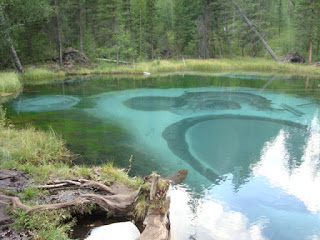Siberian Culture in the Golden Altai
Curriculum materials
Grade 9 ELA/ Social Studies
This post presents EXCERPTS from the lessons plans I prepared as a result of the Summer Fulbright-Hayes Cultural Exchange in the Altai Regions.
This post presents EXCERPTS from the lessons plans I prepared as a result of the Summer Fulbright-Hayes Cultural Exchange in the Altai Regions.
What can we
understand about geography and climate from the details in photographs?
How are the beliefs
of a culture evident in the genesis or epic tales of a culture?
How do geography and
history surface differently in the epic tales of different cultures?
Overview
These lessons introduce grade 9 students who are fluent in
experiential learning to the Altai region of Siberia as a new geographic region
and culture. The lessons use primary source documents, images, realia,
informational texts, literature and music to engage students in a virtual
expedition to self-identify evidence of cultural beliefs. The hook is a video
of indigenous singers performing traditional music, some instruments will be
present in class. Students will work reflectively to identify known features of
the music and culture and participate in collaborative discussions to share
their reflections and understandings. Then they will work collaboratively to
identify important geographic details from images of the region. Students will
work together to draw inferences about the region and culture. Students will
compare Altai legends and myths to legends and myths of other cultures.
Students will discover important symbols of the Altai culture, cedars, mountains, rivers, fire, the yurt, the deer, the Ael, the Gryphon, and be able to
explain the importance and meaning of those symbols.
We are gathered in an Ael to hear the musician, Emil Tyrkishev
 |
| The Ob River runs through Barnaul |
 |
| Lake Teletskoye |
 |
| Near the Biya River |
 |
| Near Katun and Chemal Rivers |
 |
| Blue Clay Pond Near Chemal |
 |
| Yurts |
 |
| Mt Belukha is 4,506 feet high. |
 |
| Near Kosh Agach, near Mongolia |
 | ||
| The Ak Cholyushla gorge |
Lesson 1: Workshop 2.0 Altai People and Culture Through
Music and Images- gallery walk and small group discussions.
Objectives-
Students will discover a culture and people they have not learned about before
through music and images.
Lesson 2: Altai Myth
and Legend- Close read, modeling and partner discussions.
Objectives-
Students will read and discuss Myths and legends of the Altai people and how
the texts reflect the values of the culture.
“The Hunter and the Cedars”, (Retold
from oral version by Yelena Shushakova. Fredrick, 2015)
Once, long ago, there was a hunter
passing through this way on a cold wet night. The hunter lay to rest
below the largest of three great cedars. The tree creaked in the wind above. As
the man laid his head on the bed of the cedar roots he heard the large cedar low
and sad. But he he also heard the small cedar speak clearly, “Grandfather
cedar, why do you hang so low an weep?”
The hunter listened carefully as the
old cedar answered from above, “I am old and tired,” he sighed and creaked. “I
would like to lie down and take a rest, grandson. I would like to fall into the
earth, but this man below me needs my shelter. So, I stand,” and he creaked and
moaned with the wind.
The hunter was listening below and
tears filled his eyes. He was deeply grateful for the shelter, and for the love
of this tree.
The hunter rose and hugged the old
tree and said, “Thank you, thank you, great tree, thank you great cedar.” He
placed his things below the young tree and watched the great tree lie down to
rest.
This hunter returned safely
home and told his children and they all told their children, you must always
thank the cedar for all the food, warmth, and shelter they provide.
Lesson 3 Altai
Symbols and beliefs- Jigsaw lesson
Objectives- Students will review texts of creation tales of
various cultures and identify important symbols and beliefs of the various
cultures.










